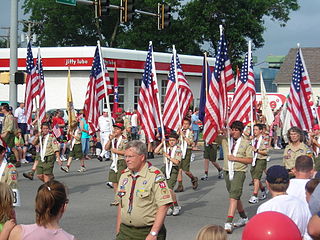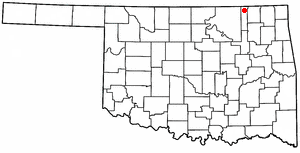
Washington County is a county located in the northeastern part of the U.S. state of Oklahoma. As of the 2020 census, the population was 52,455. Its county seat is Bartlesville. Named for President George Washington, it is the smallest county in Oklahoma in total area, adjacent to the largest county in Oklahoma, Osage County.

Scouting in Oklahoma has a long history, from the 1910s to the present day, serving thousands of youth in programs that suit the environment in which they live.

Okmulgee is a city in and the county seat of Okmulgee County, Oklahoma, United States, and is part of the Tulsa Metropolitan Area. The name is from the Muskogee word okimulgee, which means "boiling waters". The site was chosen because of the nearby rivers and springs. Okmulgee is 38 miles south of Tulsa and 13 miles north of Henryetta via US-75.

Copan is a town in Washington County, Oklahoma, United States. The population was 733 at the 2010 census, a decline of 7.9 percent from the figure of 796 recorded in 2000.

Bartlesville is a city mostly in Washington County and Osage County, Oklahoma. The population was 37,290 at the 2020 census. Bartlesville is 47 miles (76 km) north of Tulsa and 18 miles (29 km) south of the Kansas border. It is the county seat of Washington County. The Caney River runs through Bartlesville.

The Price Tower is a nineteen-story, 221-foot-high tower at 510 South Dewey Avenue in Bartlesville, Oklahoma. It was built in 1956 to a design by Frank Lloyd Wright. It is the only realized skyscraper by Wright, and is one of only two vertically oriented Wright structures extant; the other is the S.C. Johnson Wax Research Tower in Racine, Wisconsin.

The Boston Avenue United Methodist Church, located in downtown Tulsa, Oklahoma, and completed in 1929, is considered to be one of the finest examples of ecclesiastical Art Deco architecture in the United States, and has been placed on the National Register of Historic Places. Built by a congregation of the Methodist Episcopal Church, South, it was designated a National Historic Landmark in 1999. It has 15 floors.
Bruce Alonzo Goff was an American architect, distinguished by his organic, eclectic, and often flamboyant designs for houses and other buildings in Oklahoma and elsewhere.

Green Country, sometimes referred to as Northeast Oklahoma, is the northeastern portion of the U.S. state of Oklahoma, which lies west of the northern half of Arkansas, the southwestern corner the way of Missouri, and south of Kansas.

Area codes 918 and 539 are telephone area codes serving Tulsa and northeast Oklahoma. Besides Tulsa, these area codes cover cities such as Bartlesville, Broken Arrow, Claremore, Gore, Jenks, McAlester, Muskogee, Okmulgee, Pryor, Sapulpa, Tahlequah, and northeastern Oklahoma.

Boller Brothers, often written Boller Bros., was an architectural firm based in Kansas City, Missouri which specialized in theater design in the Midwestern United States during the first half of the 20th century. Carl Heinrich Boller (1868–1946) and Robert Otto Boller (1887–1962) are credited with the design of almost 100 classic theaters ranging from small vaudeville venues to grand movie palaces.

KTGX is a commercial FM radio station licensed to Owasso, Oklahoma, and serving the Tulsa metropolitan area. It airs a country music format and is owned by iHeartMedia, Inc. The studios are in the BancFirst building at the southwest corner of 71st Street and Yale Avenue in Southeast Tulsa. In morning drive time it carries the nationally syndicated Bobby Bones Show. Local DJs include Karla Cantrell, Natalie Cash and Kasper. Overnight, the station carries After Midnight with Granger Smith.

Central High School is the oldest high school in Tulsa, Oklahoma. It was founded in 1906 as Tulsa High School, and located in downtown Tulsa until 1976. The school now has a 47-acre (19 ha) campus in northwest Tulsa. Tulsa Central is part of the Tulsa Public Schools, Oklahoma's largest school district, and is a public school for students from grades 9 through 12. Since 1997 it has served as a fine and performing arts magnet school.

John Duncan Forsyth was a Scottish-American architect who became prominent in Oklahoma. Based in Tulsa and working in a variety of styles, he was connected with a number of significant buildings around the state.

Bartlesville High School is a public high school located in Bartlesville, Oklahoma. Built in 1939, it was originally called College High School, and until 1950 housed a junior college as well as the high school. Its Streamline Moderne building was designed by Tulsa architect John Duncan Forsyth. In 1982 Sooner High School and College High School unified to create Bartlesville High School at the former College High School site. The first graduating class of Bartlesville High School was in 1983.

Keene & Simpson was an American architectural firm based in Kansas City, Missouri, and in practice from 1909 until 1980. The named partners were architects Arthur Samuel Keene FAIA (1875–1966) and Leslie Butler Simpson AIA (1885–1961). In 1955 it became Keene & Simpson & Murphy with the addition of John Thomas Murphy FAIA (1913–1999), who managed the firm until his retirement in 1980.
The following is a timeline of the history of the city of Tulsa, Oklahoma, United States.
Adah Matilda Robinson was an American artist, designer and teacher, who influenced many other artists, especially architects, during the first half of the 20th century. Born in Indiana, she was educated in art schools in the Chicago area, as well as receiving private lessons from noted artist there during the late 19th century. Adah moved with her family to Oklahoma City, where she began teaching art. She moved to Tulsa and became the first art teacher at Tulsa High School. One of the pupils in her first class was the aspiring artist, Bruce Goff. Later, she taught another student, Joseph R. Koberling, Jr., who would also become a noted architect. In 1928, she was hired as the founder and chairperson of the Art Department at the University of Tulsa.
Rush, Endacott and Rush was an American architectural firm known for its designs in Tulsa, Oklahoma, from 1912 to 1929.
















